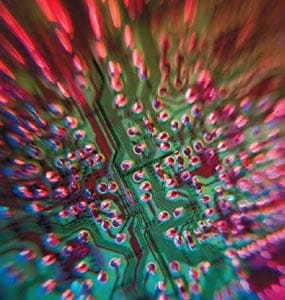The Story of Semiconductors
John Orton
2004 Oxford University Press 522pp £35.00/$54.50hb

In recent decades it has become almost impossible to accomplish anything significant without employing semiconductor devices. New cars are rife with them, from the microchip regulating the fuel injector to light-emitting diodes (LEDs) illuminating the dashboard. Look up at a traffic light and you are increasingly likely to be staring at still more LEDs. Answer your mobile phone and you are invoking another complex chain of semiconductor devices.
Laser pointers and printers, CDs and DVDs, supermarket scanners and fibre-optic communications systems all rely on semiconductor lasers. At the heart of every digital camera and video camera sits a multi-megapixel charge-coupled device made of silicon that records the images falling upon it. Far-more sophisticated silicon detectors can be found at the focus of every major telescope today – as well as at the core of the gigantic particle detectors used at colliding-beam accelerators.
And, of course, we cannot forget computers. Semiconductor microprocessors and memories have converted them into personal, portable, ubiquitous devices that one can purchase for a week’s wages in many places. Without the microchips that made this transformation possible, only government-funded agencies and large corporations could ever have afforded to own and operate computers.
Semiconductors have delivered what not long ago was unimaginable computing and telecommunications power into the hands of the masses. In a certain very real sense, they define what it means to be modern today. Yet if I cast around for useful literature on this revolutionary transformation in human affairs, which has occurred in the 50 or so years since the invention of the transistor, I encounter great difficulty. I can count the good books about the history of semiconductor technology on the fingers of one hand. There are business books aplenty on the rise of Silicon Valley and its innovative culture, for example, but few of them delve very far into the materials science and technology behind this epochal emergence. By contrast, nuclear physics and technology can boast shelves full of good histories and biographies, including a Pulitzer Prize winner by Richard Rhodes.
Thus I am pleased to welcome the addition of John Orton’s new book, The Story of Semiconductors, to the small but growing collection of worthwhile literature on the history of semiconductor science and technology. A professor emeritus of electrical and electronic engineering at the University of Nottingham in the UK, Orton has pulled together a wide-ranging survey that covers nearly all the important technological aspects in the emergence of this oft-overlooked discipline.
And he does so with a fair amount of technical depth. This is not a book for the scientifically faint of heart. There is plenty of physics and chemistry involved in his discussions; readers wanting to crack this book will need a good general grounding in these fields, as well as a fair understanding of electrical circuitry. But I view that as a plus, for it is difficult to understand semiconductor history in depth without digging into the materials science and technology underpinning it.
After a brief summary of semiconductor prehistory in the 19th and early 20th centuries, Orton launches into detailed chapters on crystal rectifiers and the transistor, which was invented at Bell Labs in December 1947 by two solid-state physicists, John Bardeen and Walter Brattain. He includes the crucial contributions of chemists and metallurgists to transistor development during the 1950s – for example the zone-refining and crystal-growing techniques that provided uniform, high-purity germanium and silicon. I especially appreciated the sidebars in which he delves into more technical detail on such topics as “minority carrier diffusion”. This process is crucial to the behaviour of the junction transistor, which was conceived at Bell Labs in early 1948 by William Shockley.
A firm grounding in these basics enables readers to understand bipolar transistors and much of the rest of the succeeding material. There is the obligatory chapter on the development of silicon technology and integrated circuitry, where the focus shifts to field-effect and metal-oxide-silicon (MOS) transistors. After that, Orton provides thorough discussions of compound semiconductors, heterostructures and lasers, and light-emitting diodes. Here on his home intellectual turf he truly shines.
Until I digested the excellent sidebars accompanying these chapters, I never really appreciated the distinction between direct band-gap semiconductors such as gallium arsenide and indirect-gap semiconductors like silicon. Nor had I understood the different methods of epitaxial crystal growth that are used to make thin-film transistors and semiconductor heterostructures. Now I do.
In such a wide-ranging portrait of any discipline as diverse as semiconductor science and technology, however, something will necessarily be overlooked – or at least accorded only passing mention. Here it is the human element. Readers will get little feeling for the distinctive personalities involved in this intriguing story – such larger-than-life figures as Shockley and the co-inventor of the integrated circuit Robert Noyce.
Nor will they be able to appreciate very much of the sociological, political, military and economic impacts of events occurring beyond the field – what historians call “externalities”. This is definitely an “internalist” account of semiconductors focused on the devices they make possible and the materials science and technology behind these gizmos, not a full-fledged intellectual history of their emergence and application.
But that would be expecting too much – and would likely require another 500 pages to achieve! Orton has provided a valuable contribution for those of us studying semiconductor science, technology and industry by packing within a single volume most of what we need to know about its technical content. And he has accomplished this worthwhile task with considerable aplomb, without bogging down less-adept readers in needless jargon.
The Story of Semiconductors will go up onto my bookshelf next to the few other good volumes about semiconductor science and technology. It will come back down often, particularly when I need to understand some technical aspect of this field in greater depth.



